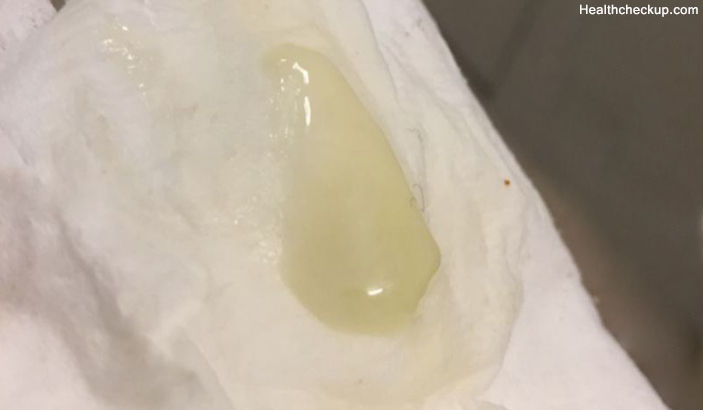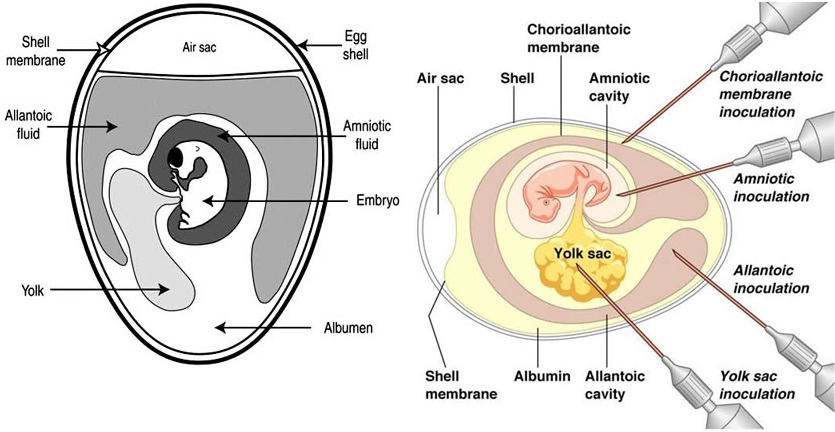Yellow discharge during early pregnancy
Yellow Discharge During Pregnancy: Symptoms & Risks
Yellow vaginal discharge could be a sign of an infection. If you’re pregnant and have yellow vaginal discharge, make an appointment to see your doctor.
Your healthcare provider will likely collect a sample of your urine or swab the discharge from your cervix for laboratory testing.
Although testing might show that you have nothing to worry about, yellow vaginal discharge might indicate an infection that could affect your pregnancy.
Conditions that could have yellow discharge as a symptom include:
- bacterial vaginosis
- yeast infection
- chlamydia
- gonorrhea
- trichomoniasis
Too much of a certain kind of bacteria in the vagina results in bacterial vaginosis (BV). Although there is no consensus in the scientific community regarding the cause of BV, the Centers for Disease Control and Prevention (CDC) indicates that it typically affects those who are sexually active.
What are the symptoms of BV?
Although many women do not have symptoms, you might experience:
- vaginal discharge that could have a yellow hue
- vaginal discomfort
- itch in and around your vagina
- unpleasant vaginal odor, especially after sex
- burning sensation when urinating
Can BV impact my pregnancy?
According to the CDC, if you are pregnant and have BV, you have a greater risk than pregnant women without BV for:
- preterm labor
- premature delivery
- premature rupture of membranes
- chorioamnionitis, a bacterial infection also known as amnionitis
- low birth weight (under 5.5 pounds)
- endometritis
A vaginal yeast infection, also called vaginal candidiasis, is a fungal infection. According to the Mayo Clinic, pregnancy can disrupt your vagina’s pH balance, making yeast infections common during pregnancy.
What are the symptoms of a yeast infection?
If you have a vaginal yeast infection, some symptoms you might experience include:
- thick, odor-free discharge resembling white or yellowish cottage cheese
- itching in and around the vagina
- burning sensation while urinating or during sex
- swelling and redness of the vulva
Can a yeast infection impact my pregnancy?
A 2015 study indicated that, although evidence is incomplete, candidiasis in pregnancy might be associated with an increased risk of pregnancy complications, such as:
- premature rupture of membranes
- preterm labor
- chorioamnionitis
- congenital cutaneous candidiasis, a rare condition characterized by skin rash
If you are pregnant, talk to your doctor about safe alternatives for treating your yeast infection. You should avoid certain antifungals such as fluconazole (Diflucan) when pregnant.
You should avoid certain antifungals such as fluconazole (Diflucan) when pregnant.
Chlamydia is a common bacterial sexually transmitted infection (STI) that can be cured with antibiotics.
What are the symptoms of chlamydia?
Most people do not have symptoms of chlamydia and are unaware that they have it. Women who do have symptoms might experience:
- atypical vaginal discharge, often yellow, with a strong odor
- discomfort when urinating
- need to urinate more often than usual
- discomfort during sex
- discomfort in the lower belly area
Can chlamydia impact my pregnancy?
An untreated chlamydial infection, according to the CDC, has been linked to complications during pregnancy, such as:
- premature rupture of membranes
- preterm labor
- low birth weight
The infection can also be transmitted during delivery, possibly leading to lung and eye infections.
Gonorrhea is a common STI that is treated with antibiotics. Drug-resistant strains of gonorrhea are increasing, so it is becoming increasingly difficult to cure.
Drug-resistant strains of gonorrhea are increasing, so it is becoming increasingly difficult to cure.
What are the symptoms of gonorrhea?
Although most with gonorrhea have no symptoms, those who do might experience:
- increased vaginal discharge, often yellow
- discomfort while urinating
- discomfort during sex
- abdominal discomfort
Can gonorrhea impact my pregnancy?
According to the CDC, an untreated gonococcal infection during pregnancy has been linked to:
- miscarriages
- premature rupture of membranes
- chorioamnionitis
- premature birth
- low birth weight
Gonorrhea can also be transmitted through delivery. This can lead to eye infections if not treated.
An infection with a protozoan parasite (Trichomonas vaginalis) causes the common STI trichomoniasis.
What are the symptoms of trichomoniasis?
According to the CDC, only about 30 percent of the estimated 3. 7 million people in the United States with trichomoniasis will develop symptoms. If you do experience symptoms, they might include:
7 million people in the United States with trichomoniasis will develop symptoms. If you do experience symptoms, they might include:
- increased vaginal discharge, often yellow with an unpleasant odor
- discomfort while urinating
- discomfort during sex
- redness of the genitals
- soreness and itching of the genitals
Can trichomoniasis impact my pregnancy?
If you have trichomoniasis and are pregnant, you’ll be more likely than pregnant women who do not have trichomoniasis to:
- have your baby early (preterm)
- have a low birth weight baby
When you are pregnant, your vaginal discharge can vary in volume, texture, and color. While some changes are normal, others may indicate a problem, such as an infection.
If your discharge is yellow, see your doctor. Especially if it has a strong, unpleasant odor. Yellow vaginal discharge could be a sign of:
- bacterial vaginosis
- yeast infection
- chlamydia
- gonorrhea
- trichomoniasis
If it is an infection, your doctor can get you started on treatments right away, not only for your health but for the health and safety of your baby.
Yellow Discharge During Pregnancy: Causes, Treatment, and Risks
When you’re not pregnant, yellow discharge can be pretty normal. If the texture is not chunky and there’s no “off” scent, this color is often a result of supplements or certain foods. (And uh, isn’t that supplement life kind of the norm when pregnant?)
But it’s valid to be concerned when a color that wasn’t there yesterday is today. Is your body (or baby?) using the discharge to tell you something you should know — ASAP??
It could be nothing to sweat about but if there are other symptoms, yellow discharge might be a sign of infection, which could impact your pregnancy.
Yellow discharge during pregnancy can be a symptom of several conditions
Here are some common ones:
- bacterial vaginosis
- chlamydia
- gonorrhea
- trichomoniasis
- yeast infection
Left untreated, these conditions could affect your pregnancy or the baby could get an infection during birth.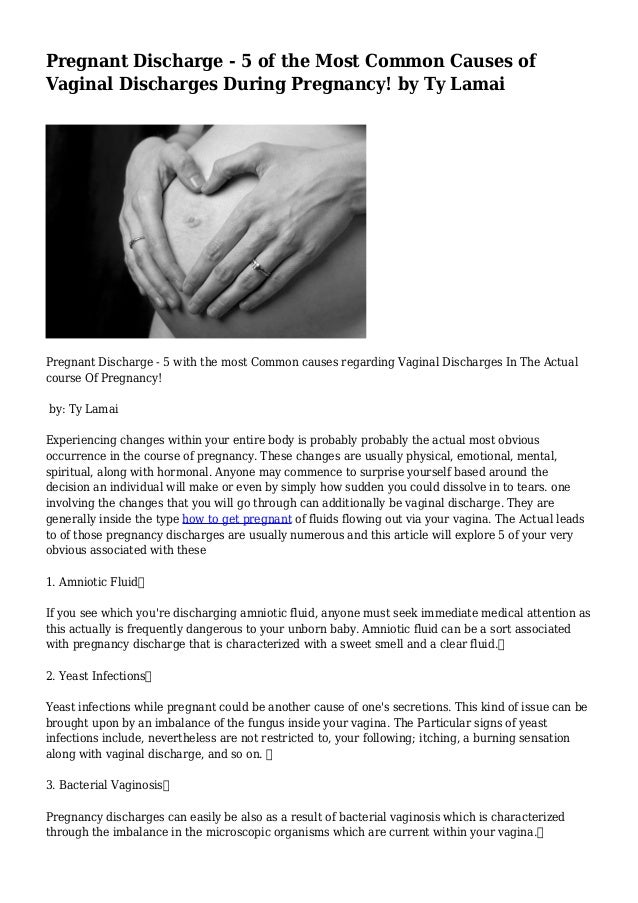 The good news is most of these conditions can be treated, safely, at anytime during your trimesters.
The good news is most of these conditions can be treated, safely, at anytime during your trimesters.
Your best move? Have your doctor check you out. Tell them your symptoms and they’ll run tests to determine the cause of your yellow discharge and if it’s a cause for concern.
Healthy discharge might be clear, white, or a slightly off-white or beige color. If you notice a bright yellow (like some dandelions got in your undies) or if there was an obvious change in the texture, smell, or color of your discharge, you should check in with your doc.
Amniotic fluid
Amniotic fluid, although typically clear, can also look yellow sometimes. If you think your water broke or if you’re having lots of watery discharge, especially if you’re seeing yellow, let your doctor know.
Here are some common conditions behind yellow discharge and how they can be treated.
Bacterial vaginosis (BV) can happen when you have more “bad” than “good” bacteria. Think of it like an upset microbiome in the vagina.
It’s a pretty common condition (in fact the most common vaginal condition for vagina owners between the ages of 15 to 44) for those who have sex. In fact, you might not even have symptoms.
It’s not clear why BV happens, but the Centers for Disease Control and Prevention (CDC) notes that douching and frequent sex increases the risk. BV also appears to be more common in the second and third trimester.
BV symptoms
BV doesn’t always cause symptoms — and your discharge may not always be yellow (it could be white or grey). But when serious, you might also feel:
- vaginal pain or discomfort
- itching or burning in or around your vagina
- fishy vaginal odor (especially post-sex)
- burning or pain when peeing
Treating BV during your pregnancy
During a pregnancy, BV can be safely treated with antibiotics in the form of a pill, gel, or cream.
If you’re sexually active, you’ll definitely want to see the doc as treatment can help reduce your risk for STIs. Partners with a vulva may also transfer the bacteria back and forth.
Partners with a vulva may also transfer the bacteria back and forth.
Don’t go untreated
Sometimes BV might even go away without treatment, but as a pregnant person, you don’t want to risk it. Untreated BV during pregnancy is associated with a higher risk for a variety of concerns, such as:
- miscarriage
- preterm labor
- greater risk of STIs
- low birth weight
Vaginal yeast infection (aka vaginal candidiasis), caused by a fungus, is the second most common vaginal infection in the U.S.. And it appears to be more common in the third and second trimester than first.
Raging pregnancy hormones can muck up the pH balance in your vagina. This, in turn, makes you more likely to get a yeast infection if you’re pregnant.
Yeast infection symptoms
- red, swollen vulva
- burning or itching
- painful or uncomfortable urination
- thick, cottage cheese-like discharge
Treating yeast infection during pregnancy
Treatment for yeast infections depends a bit upon your symptoms. Your doctor will recommend the proper — pregnancy-safe — antifungal meds, like topical nystatin, suited to your needs. The med you’ll want to avoid, especially during your first trimester, is fluconazole.
Your doctor will recommend the proper — pregnancy-safe — antifungal meds, like topical nystatin, suited to your needs. The med you’ll want to avoid, especially during your first trimester, is fluconazole.
While there’s emerging evidence that untreated vaginal yeast infections may increase the risk of several pregnancy complications, research notes that more studies are needed to determine a definitive causation.
Chlamydia is the most common treatable sexually transmitted bacterial infection worldwide. It’s cured with antibiotics. If you test positive for chlamydia, you should get a cure that works in 3 to 4 weeks.
After that you should be retested after 3 months (and in your third trimester) to make sure you’ve recovered.
Chlamydia symptoms
Chlamydia can be a silent menace — many people are symptom-free and unaware that they have it. But, some women experience:
- unusual, strong-smelling often-yellow vaginal discharge
- frequent need to pee
- discomfort when peeing
- abdominal pain
- painful sex
Treating chlamydia during pregnancy
Treatment will depend on which trimester you’re in as some medications (like doxycycline) shouldn’t be taken during your second and third trimester. Safe antibiotics for pregnancy include azithromycin, erythromycin, or amoxicillin.
Safe antibiotics for pregnancy include azithromycin, erythromycin, or amoxicillin.
Left untreated, chlamydia can affect the baby
Conditions that may occur for the baby, as a direct result of chlamydia, are:
- an eye infection
- lung infection
- pneumonia
Gonorrhea is another common STI. It, too, is treated with antibiotics. But as it’s slowly becoming drug-resistant, it can make the infection harder to cure.
A gonorrhea infection is associated with a 40 to 60 percent chance of a low birth weight, so it’s recommended to be screened during your first and third trimester, if you’re at high risk. It’s also associated with risk of preterm delivery.
Gonorrhea symptoms
At the risk of sounding like a broken record here: Symptoms aren’t common (which is also why doctors screen you regardless). But if you do have them, you might also notice:
- vaginal discharge, frequently yellow
- discomfort when peeing
- abdominal pain
- painful sex
Treating gonorrhea during pregnancy
The good news is that treating gonorrhea during pregnancy is possible. Antibiotic treatments, like ceftriaxone and azithromycin, improve birth outcomes.
Antibiotic treatments, like ceftriaxone and azithromycin, improve birth outcomes.
Untreated gonorrhea
It’s possible for an infection transmission during birth (30 and 47 percent chance). This can cause:
- infections on the scalp
- infections in the eye, lungs, or genitals
- blindness
- low birth rate or undersized baby
Untreated gonorrhea has also been linked to:
- miscarriage
- premature rupture of the amniotic sac
- chorioamnionitis
- endometritis
- pelvic sepsis
Trichomoniasis (aka TV or Trich) is the most common non-viral STI. It’s caused by a pesky little parasite and treated with antibiotics. If you’re in a high-risk situation (history of STIs/STDs, multiple sex partners), you’ll want to be screened for TV frequently.
Trichomoniasis symptoms
According to the CDC, symptoms are not always present and can also vary from person to person. Among the possible symptoms are:
- increased vaginal discharge, often greenish-yellow and possibly “frothy”
- pain when peeing
- painful sex
Treating trichomoniasis during pregnancy
Needless to say, trich and pregnancy are not a match made in natal heaven.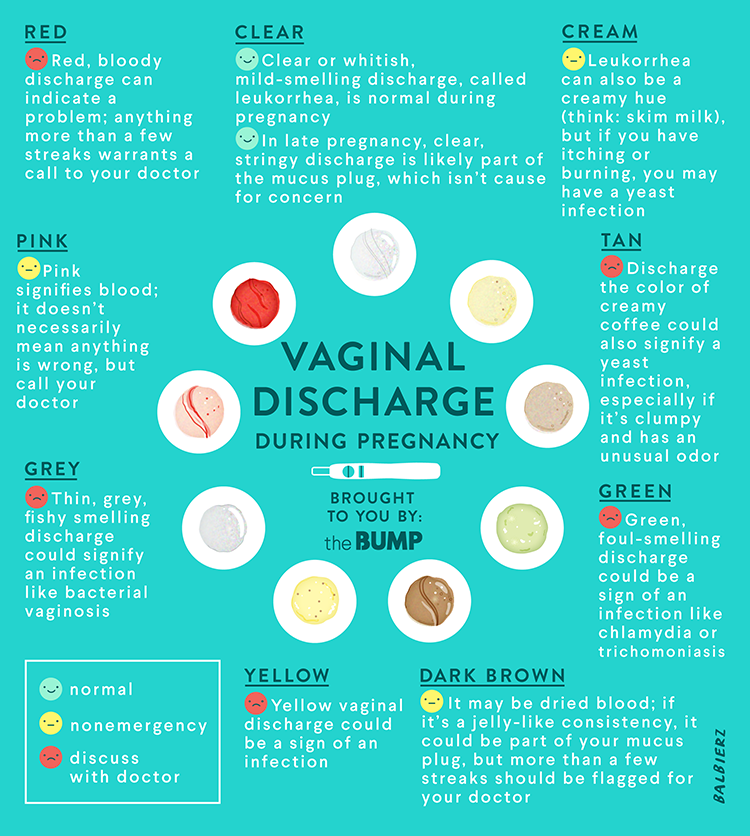 Trichomoniasis can do a lot to your immune system, making you more susceptible to infections, including HIV and preterm birth. Thankfully, treatment is simple and safe for pregnancy.
Trichomoniasis can do a lot to your immune system, making you more susceptible to infections, including HIV and preterm birth. Thankfully, treatment is simple and safe for pregnancy.
You only need a single dose of prescription mediation. You’ll want to make sure your partners get treated too as 1 in 5 people get re-infected within 3 months (luckily the same medication works!).
Untreated TV
Left without treatment, this infection can increase the risk of:
- premature rupture of the amniotic sac
- preterm labor
- increased risk of contracting HIV
- low birth weight
Generally, discharge is nothing to worry about. It’s a natural, healthy part of your body’s adjustment to pregnancy. A slight change in color, odor, texture, and taste is a common first experience in pregnancy. This change can start in the first trimester and lasts the entire pregnancy.
Normal pregnancy discharge is usually mucusy, somewhere on the whitish-to-yellowish spectrum, and doesn’t smell much.
If you’re not sure you’re pregnant and are just going off by discharge (because you haven’t had time to go buy a pee-stick), yellow discharge may be a sign of early pregnancy. In this scenario, implantation bleeding can cause a color change in your discharge.
As fun as intuition is, we recommend buying a pregnancy test to confirm.
If your discharge is accompanied by any of the following additional symptoms, you should beeline it to your OB/GYN. These are typical signs of infection (which should be attended to, pregnant or not):
- drastic change in the amount of discharge
- sudden change in the color, especially if it becomes greenish or grayish
- changes in the consistency, especially if it becomes watery or thick/curd-like
- bad odor
The primary concern in all of the potential scenarios listed above is if you let it go untreated.
For a recap, here’s what risks could come true if yellow discharge *is* a sign of infection and it’s not treated:
| Your risks: | Baby’s risk: |
| miscarriage | low birth weight |
| premature rupture of the amniotic sac | increased death rate |
| preterm labor | eye infection |
| endometritis | pneumonia |
| pelvic inflammatory disease | |
| infections like chorioamnionitis (aka amnionitis) |
Sometimes yellowy vaginal discharge during pregnancy is no big deal — or it’s a sign of pregnancy in itself. Other times, it’s a red flag, your body’s warning. Especially if your discharge is accompanied by a foul odor or any kind of itching, burning, or pain.
Other times, it’s a red flag, your body’s warning. Especially if your discharge is accompanied by a foul odor or any kind of itching, burning, or pain.
To find out what’s what, visit your doctor. As mentioned, many of these conditions can be safely and effectively treated. Getting immediate care is key to keeping you — and your baby — healthy and maintaining a storybook (or at least textbook) pregnancy.
what they are and what they talk about
Published:
There are many changes in the body during pregnancy. One of them is a change in color, consistency and volume of secretions. Which of them are considered a normal symptom of pregnancy, and which should alert, medical journalists Stephanie Watson and Hope Kristol tell.
One of them is a change in color, consistency and volume of secretions. Which of them are considered a normal symptom of pregnancy, and which should alert, medical journalists Stephanie Watson and Hope Kristol tell.
We have launched a newsletter for pregnant women. Subscribe to receive regular information relevant to your term.
What can be discharge during pregnancy? The discharge can be clear, white, green, grey, brown, pink or red. The secretions are made up of fluid and dead cells, so the color indicates changes in the body.
Clear or milky white
If the discharge is clear or milky white, there is nothing to worry about. This is a normal color characteristic of a healthy body. In this case, the discharge is practically odorless. In early pregnancy, they become more abundant, which is associated with increased blood flow and estrogen production. However, in the late stages of pregnancy, thick and jelly-like transparent discharge indicates disturbances in the functioning of the body.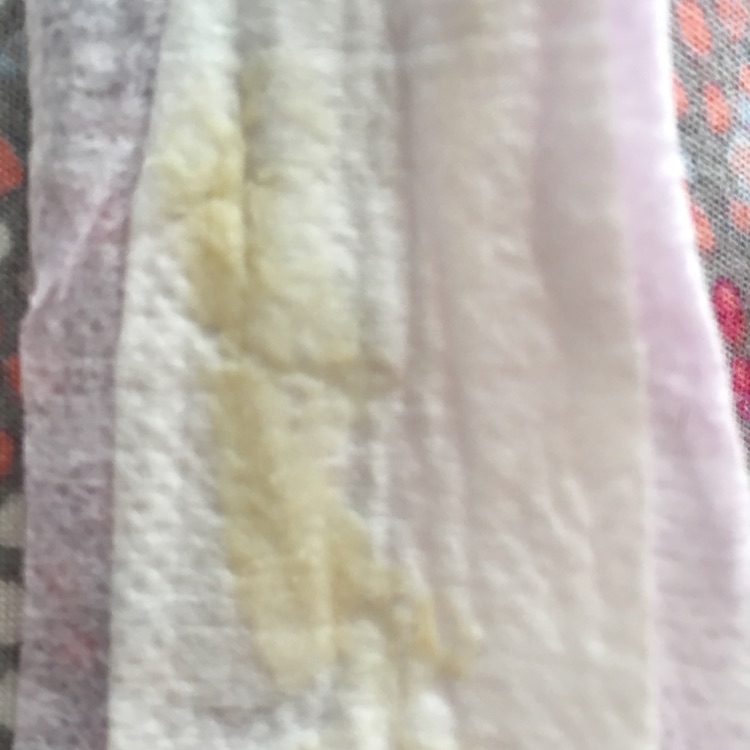
White and lumpy discharge
What does thick discharge mean during pregnancy? Discharge that is lumpy, white or cloudy white, resembling cottage cheese, indicates a yeast (fungal) infection, writes journalist Jane Leonard. Yeast infections are common and the body is especially susceptible to them during pregnancy. Other symptoms include itching, burning, and painful urination.
A pregnant woman holding a model of the pelvic organs in her hands: iStockPhotoGreen or yellow
Yellowish discharge does not indicate a health condition, as it can naturally change color in the air. Darker yellow or green discharge, especially if it is thick, profuse, or accompanied by an unpleasant odor, is an indication to see a doctor.
What does yellow discharge during pregnancy indicate? Medical journalist Scott Frotingham writes that yellow and greenish vaginal discharge can be a sign of an infection such as:
- bacterial vaginosis;
- thrush;
- chlamydia;
- gonorrhea;
- trichomoniasis.

If yellow discharge is accompanied by additional symptoms (itching, pain, redness), you should consult a doctor and make sure that this does not pose a danger to the pregnant woman and the fetus.
Gray discharge
Gray vaginal discharge indicates a vaginal infection called bacterial vaginosis (BV), especially if it has a fishy odor that worsens after intercourse.
Bacterial vaginosis is a consequence of a bacterial imbalance in the vagina. Frequent douching and having multiple sexual partners are considered increased risk factors. Health writer Stephanie Watson reminds us that excessive hygiene has a negative effect on the body. This leads to a violation of pH and makes the body more vulnerable. Avoid douching or using any strong products containing fragrances, dyes, or harsh chemicals.
Brown discharge
Brown discharge is characteristic of the implantation period and is considered an early sign of pregnancy, writes Lauren Sharkey. Implantation occurs when a fertilized egg implants in the lining of the uterus. This occurs about 1-2 weeks after conception and is accompanied by light bleeding of various shades, including brown.
Implantation occurs when a fertilized egg implants in the lining of the uterus. This occurs about 1-2 weeks after conception and is accompanied by light bleeding of various shades, including brown.
Sometimes a fertilized egg is implanted in the fallopian tubes or in the ovary, abdomen, or cervix. This is called an ectopic pregnancy and is accompanied by a smearing brown discharge.
Brown discharge during pregnancy is not usually a cause for concern. However, pregnant women who experience dark brown discharge should see a doctor.
Pink discharge
Why is there pink discharge during pregnancy? Pink discharge during pregnancy can be both the norm and a sign of disorders. Discharge with a pink tint often occurs in early pregnancy or in the last weeks, when the body is preparing for childbirth. It can also happen before a miscarriage or during an ectopic pregnancy, notes Jane Leonard.
Doctor consulting a pregnant woman: Pexels / MART PRODUCTIONRed discharge
Bloody discharge occurs 1-2 weeks after implantation of the egg.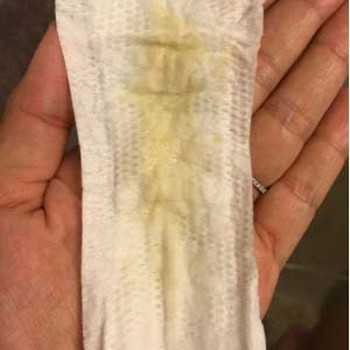 In this case, there is no cause for concern. During the first trimester, spotting can occur after sex or a gynecological exam, writes medical journalist Hope Kristol. If spotting becomes profuse, see a doctor. This may be a sign of:
In this case, there is no cause for concern. During the first trimester, spotting can occur after sex or a gynecological exam, writes medical journalist Hope Kristol. If spotting becomes profuse, see a doctor. This may be a sign of:
- miscarriage, especially in the first 13 weeks;
- ectopic pregnancy;
- premature births;
- problems with the cervix or placenta.
What discharge during pregnancy should alert? The cause for concern is abundant bloody and brown discharge, as well as yellow, greenish and gray discharge with an unpleasant odor.
Discharge during pregnancy is a normal process that accompanies the change and renewal of cells. If the discharge is clear or white, does not smell and has a uniform consistency, then there is no cause for concern. If you smell bad and your discharge is yellow, green, brown, or red, talk to your doctor.
Attention! The material is for informational purposes only. You should not resort to the methods of treatment described in it without first consulting a doctor.
Sources:
- Hope Cristol. Causes of Bloody Vaginal Discharge // WebMD. - 2021. - 06 May. — Mode of access: https://www.webmd.com/women/bloody-vaginal-discharge-causes
- Stephanie Watson. Pregnancy Discharge: Color and Texture Changes // WebMD. - 2020. - March 31. - Access mode: https://www.webmd.com/women/features/pregnancy-discharge-changes
Reviewer - doctor of the highest category Mikhailenko Lyudmila Anatolyevna.
Original article: https://www.nur.kz/health/motherhood/1840569-zeltye-vydelenia-pri-beremennosti-priciny-harakter-cto-delat/
why they appear in the early and late periods, in the 1st, 2nd and 3rd trimester, what to do at home
The period of bearing a child is always accompanied by changes in a woman's body. Including various selections appear. From
 The latter is accompanied by a sour smell, the appearance of cheesy flakes, itching and burning
The latter is accompanied by a sour smell, the appearance of cheesy flakes, itching and burning If a pregnant woman is not sure that she is correctly interpreting the color of the discharge, it is better to consult a doctor. Each person has a different perception of color, and the expectant mother may not notice the dangerous shade of discharge.
Why yellow discharge appears during early pregnancy
Light and pale yellow discharge in early pregnancy is usually considered normal. Often they appear due to changes in the microflora of the vagina and softening of the walls of the uterus due to the preparation of the body for bearing a child (1).
The following symptoms should alert:
- pain,
- burning sensation,
- itching,
- unpleasant smell,
- weakness,
- fever.
一 With such symptoms, yellow discharge at any stage of pregnancy most often signals a bacterial infection (STDs, staphylococci, streptococci and others), 一 explains obstetrician-gynecologist Elena Kollerova.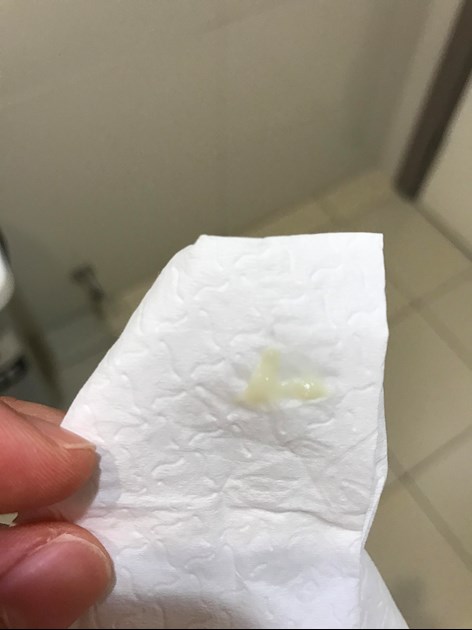 - They can cause inflammation in the vagina, cervix, uterus and ovaries, as well as provoke infection of the fetus.
- They can cause inflammation in the vagina, cervix, uterus and ovaries, as well as provoke infection of the fetus.
1st trimester
The body begins to prepare for gestation and childbirth immediately after conception. Hormonal changes occur, the hormone progesterone accumulates. It contributes to the formation of a mucous plug, the main function of which is to protect the uterine cavity from pathogenic microorganisms. It is under the influence of progesterone that a light yellow discharge can appear (2).
In some cases, yellow secretion indicates the presence of inflammatory processes - thrush, bacterial vaginosis, genital infections, cervicitis and colpitis. The main danger of pathologies during this period is due to the restriction of medications acceptable for treatment: most of them are allowed no earlier than the 12th week. Therefore, if you notice any warning signs, see a doctor as soon as possible.
Why yellow discharge appears during late pregnancy
The appearance of yellow discharge most often may indicate a pathology.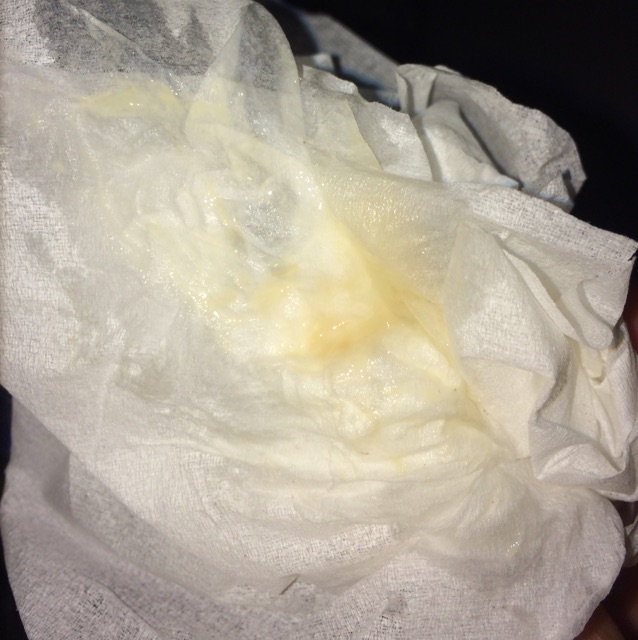 As at the beginning of pregnancy, you need to pay attention to the color, character and accompanying symptoms. The emergence of any suspicion 一 is a reason for an early visit to the gynecologist.
As at the beginning of pregnancy, you need to pay attention to the color, character and accompanying symptoms. The emergence of any suspicion 一 is a reason for an early visit to the gynecologist.
2nd trimester
Yellow discharge may also occur during the second trimester of pregnancy. Their consistency depends on the hormone estrogen. Under its influence, the vaginal secretion becomes more liquid and plentiful.
Should alert:
- dark discharge,
- unpleasant smell,
- burning,
- redness of the mucous membranes,
- fever.
Such symptoms may indicate inflammatory processes or exacerbation of chronic diseases of the reproductive system.
Photo: MART PRODUCTION, pexels.com3rd trimester
Light yellow discharge without odor or impurities is usually considered normal in the third trimester. However, they can also appear for other reasons.
- Leakage of amniotic fluid. It is considered dangerous until 37 weeks, when the baby is still premature.
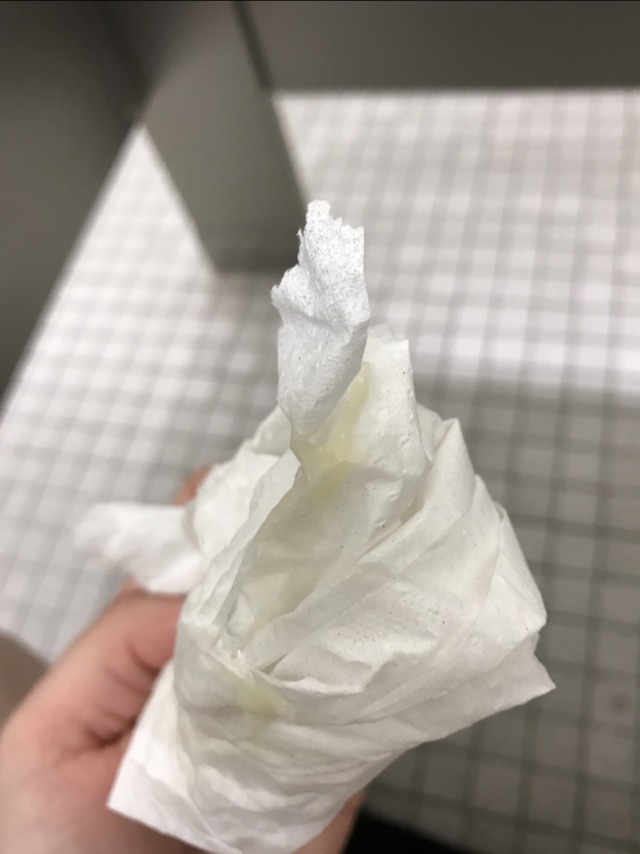
- Chorioamnionitis. This is an infection of the amniotic fluid or the inner membranes of the fetus. It is accompanied by high fever and an increased number of leukocytes. The level of the latter is determined by the results of the smear.
- Removal of the mucous plug. It is considered one of the main harbingers of childbirth.
A timely trip to the gynecologist will help protect yourself and your unborn child. If necessary, the doctor will refer you for an examination and prescribe the appropriate treatment.
What to do if yellow discharge appears during pregnancy at home
一 Yellow discharge of a saturated color at any stage of pregnancy is a signal for an urgent visit to the doctor, 一 says Elena Kollerova.一 Having noticed them, in no case should you self-medicate at home: put candles, take any drugs, and even more so use folk remedies. This can only aggravate the situation and damage the mucosa. Careful examinations such as Pap smear, PCR for STDs, and bacterial cultures can help determine the cause of the yellow discharge and prescribe treatment (3).
Popular questions and answers
We answer the most popular questions about yellow discharge during pregnancy with obstetrician-gynecologist, doctor of the highest category Elena Kollerova.
Can I play sports if I have yellow discharge?
If the discharge is not accompanied by unpleasant symptoms or odor, sports are usually allowed. Light exercise is recommended: yoga, walking and the like. But it is advisable for every pregnant woman to find out about the possibility of visiting the gym from her gynecologist.
Is the brown shade of yellow discharge always dangerous?
Brown shade 一 is always an admixture of blood. However, at the very beginning of pregnancy, it may not indicate pathology, but implantation bleeding.
It occurs due to the attachment of the ovum to the wall of the uterus.
In this case, the discharge should be without scarlet inclusions, painful sensations and short-term. However, in order to avoid risks, it is better to consult a gynecologist.